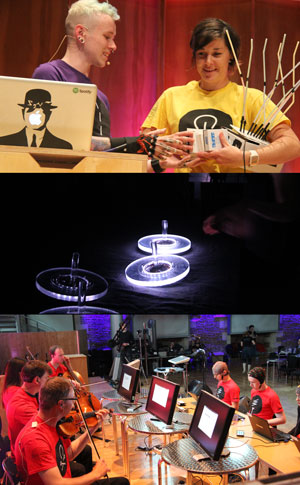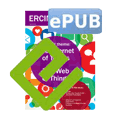by Thomas Lidy, Alexander Schindler and Michela Magas
A new Horizon 2020 Innovation Action project fosters the uptake of music technology research and acts as an accelerator for bringing creative music tech ideas to market, while providing a mesh of technological ‘bricks’ to create an ‘Internet of Music Things’.
Music is arguably the most pervasive of the performing arts. It has the power to enlighten us, cheer us up, bring us down and most importantly - bring us together. Substantial resources and personal energy have been invested into music technology research in recent decades. Despite the global success of European music tech companies such as Spotify, Deezer, Soundcloud and last.fm, the value chain from academic research to SMEs and large music industry corporations remains fragmented, preventing successful application of the results of innovative research. Yet, creative SMEs have been identified as the primary catalysts for innovation, and they can benefit vastly from innovative music technology research.
The Horizon 2020 Innovation Action ‘MusicBricks’ has been initiated with the aim of capitalizing on the current European leadership in successful music technology companies and secure a direct route from ICT academic research to the application and exploitation by SMEs and major industry players worldwide. The mission of the project is to foster an exchange between the music ICT experts from academic and national research organizations, and digital makers and content creators from creative industries SMEs.
Despite the remarkable progress in music information research, technologies provided by various projects are often difficult to apply owing to poor communication. Research results are typically scattered among institution Web pages and documentation is often neglected. Less user-friendly interfaces and steep learning curves hinder uptake by industry (even more so for SMEs and, in particular, one-person enterprises such as the typical music maker or app developer). In addition, corresponding technologies are frequently lacking proper engineering to facilitate interoperability with other technological components. Thus, complicated workflows and little connectivity hinder the creation of larger systems that operate as a mesh of technological bricks connecting physical and tangible hardware and available music technology software. Yet this interoperability between tangible and wearable devices and the well-researched software components for music analysis and processing is heavily needed to make the ‘Internet of Music Things’ a reality [1].
The MusicBricks Project
MusicBricks responds to these problems, acting as a connector between research and industry, by identifying, wrapping and making existing tools available in easily usable formats. These tools, or ‘bricks’, shall require little learning, offer themselves for mash-ups, and are easily adopted and deployable by the creative SME digital makers and content creators. The project will foster interoperability by providing state-of-the art connectors and interfaces to these technological building blocks. The resulting plethora of components - software endpoints, Web APIs, physical, tangible and wearable devices - are connected through and live on the Internet, realizing an ‘Internet of Music Things’, where many different kinds of analysis, processing, sensing, actuating or synthesis are taking place on different machines.
The consortium consists of the design research and innovation lab Stromatolite, the Institut de Recherche et Coordination Acoustique/Musique (IRCAM), the Music Technology Group of the Universitat Pompeu Fabra, the Fraunhofer IDMT Institute, the Vienna University of Technology, and is led by Sigma Orionis.
In the first step the project will provide the ‘bricks’ for creative makers: software tools and APIs, such as rhythm feature analysis and music similarity by Vienna University of Technology, key and tempo detection and melody and bass transcription from Fraunhofer, melody curve extraction and API access to the freesound.org sample collection by Universitat Pompeu Fabra. On top of these APIs, graphical interfaces (GUIs) such as PlaySOM and Sonarflow offer semi-automated grouping and clustering of music while other visual frontends shall be easily used as well in conjunction with the tools and APIs. The third category of bricks is a new generation of Tangible User Interface (TUI) such as a wireless micro platform for motion sensing provided by IRCAM [2] This is complemented by portable computing platforms such as the Arduino, the Raspberry Pi and the Axoloti, a microcontroller specifically designed to create free-form digital audio instruments of a new kind.
The Internet of Music Things
All these technological ‘bricks’ form the foundation for a co-creational space where people - musicians, hackers, digital makers, creative SMEs - build entirely new applications. By interconnecting individual nodes - the provided API endpoints, network-enabled devices, sensors, microcomputers etc. - these bricks communicate with each other and start creating something bigger: a mesh of connected ‘musical components’ which eventually manifests as an ‘Internet of Music Things’.
Events such as Hack days and Music Tech Fests fuel the creation of new mash-ups, hacks, audio tools, music instruments combined with unthought-of forms of application which has been demonstrated impressively in the past by innovations such as Siftables [3], compact devices with sensing, graphical display, and wireless communication that can be physically manipulated, recognize gestures and sense other nearby devices while able to interactively create audio; or performances such as the Brainwave Quartet in which music is performed live through the collective brainwaves of an ensemble wearing brain caps. Another great example is the “Wearable Axoloti Music Human Synthesizer”, a multi-user synthesizer where one user modulates the sound of another through touching, created with wearable electronics, conductive surfaces on T-shirts and Axoloti boards. It was awarded the ‘Internet of Music Things Hack Award’ at the Paris Music Tech Fest.
Events
MusicBricks both hosts and cooperates with a series of events, specifically the Music Tech Fest geared towards the creative developer community to actively test and utilize these tools, alongside others, to generate new ideas and create novel applications. The Music Tech Fest (Figure 1) has seen successful past events around the world and is a free, weekend-long event that provides an experimental and improvisational space where ideas are showcased, performed, demonstrated and discussed, while offering immediate assistance with the tools provided. It has a particular focus on interdisciplinarity: musicians meet hackers, researchers meet industry, artists and technologists come together. Through this interdisciplinarity it enables a new dimension of creativity, leading to entirely novel ideas and applications. In past events creative hacker ideas have led to physical products and performances featuring new musical innovations such as a ‘Music Hat’ which converts brainwaves and head movements to music and various effects.

Figure 1: Music hackers interconnecting music technology to create interactive performances, new music interfaces or instruments.
The most promising ideas and demonstrators generated at these events - whether a piece of software, a device, a new musical instrument, a performance or installation - will be supported by the MusicBricks Incubation Programme, which provides funding for residencies that enable creative makers to further develop their demonstrators to robust and market-ready prototypes and assists them through virtual and face-to-face collaboration. Feedback gathered during idea generation and incubation will assist in the consolidation and refinement of the available tools and interfaces. By exposing the resulting prototypes directly to big industry players and investors the project aims to reach the global market and gather market feedback both for deployment of sustainable applications and to ensure long term impact on future research directions.
The next MusicBricks events will be Music Tech Fest Scandinavia May 29-31, 2015 in Umeå, Sweden, and a Music Hack Day at Sónar Festival Barcelona June 17-19, 2015. Until June 2016 MusicBricks will host a set of further events and support ideas through the incubation phase throughout this period. In order to ensure sustainability, the consortium is planning to set up a Music Tech Fund in conjunction with investment company Par Equity to further support and incubate the best prototypes and help take them to market.
Links:
Music Bricks Website: http://musictechfest.org/MusicBricks
Music Tech Fest: http://musictechfest.org
Results of previous Music Tech Fests: http://musictechfest.tumblr.com
Videos from Music Tech Fests: https://www.youtube.com/user/MusicTechFest
Reference:
[1] Music’s Internet of Things: Heartbeats, Accelerometers... Brainwaves?
http://evolver.fm/2013/03/15/musics-internet-of-things-heartbeats-accelerometers-brainwaves/
[2] Jules Françoise, Norbert Schnell, Riccardo Borghesi, and Frédéric Bevilacqua.Probabilistic Models for Designing Motion and Sound Relationships. In Proceedings of the 2014 International Conference on New Interfaces for Musical Expression, NIME’14, London, UK, 2014.
[3] D. Merrill, J. Kalanithi and P. Maes. Siftables: Towards Sensor Network User Interfaces. In the Proceedings of the First International Conference on Tangible and Embedded Interaction (TEI'07). February 15-17 in Baton Rouge, Louisiana, USA.
Please contact:
Thomas Lidy, Alexander Schindler
Vienna University of Technology
Michela Magas
Stromatolite











